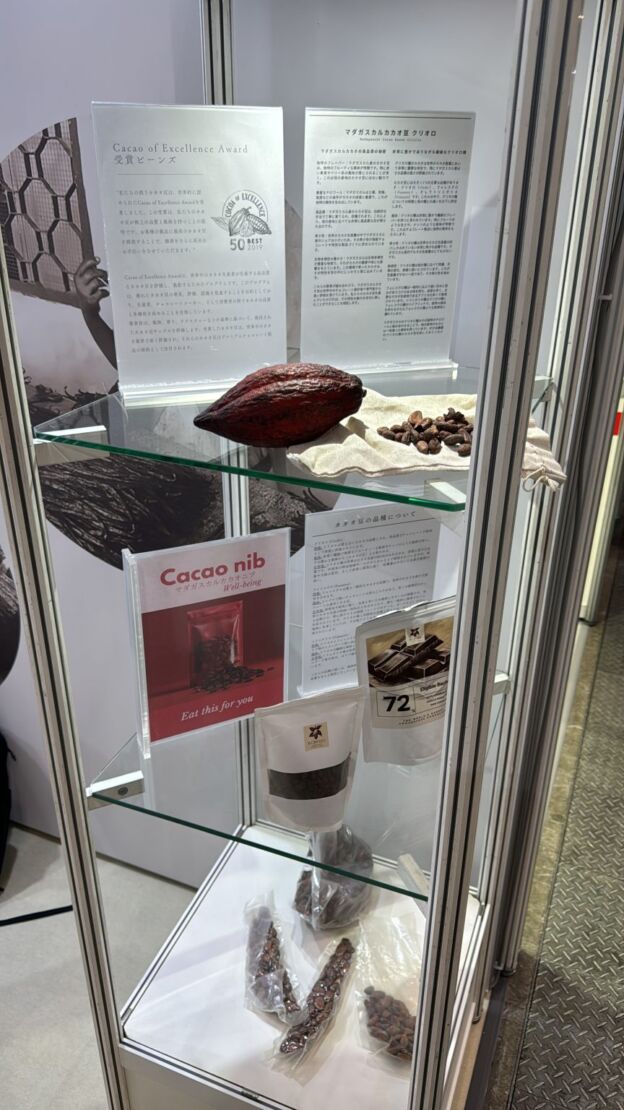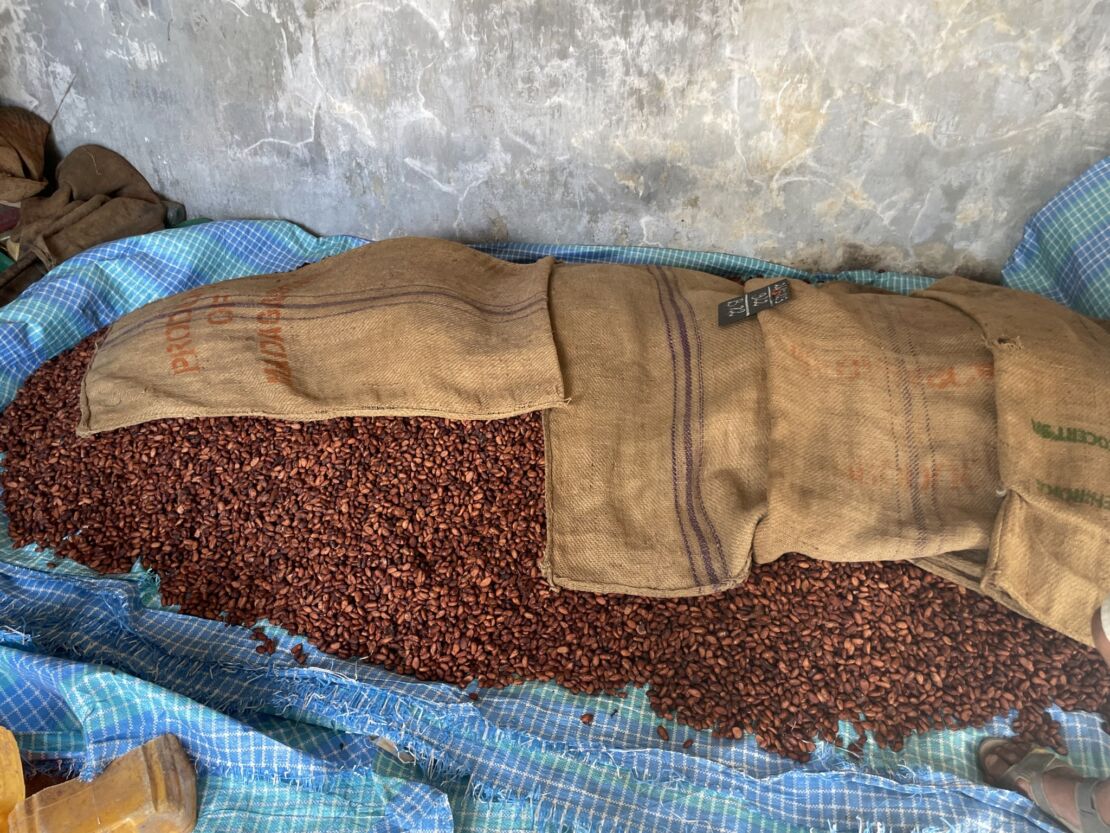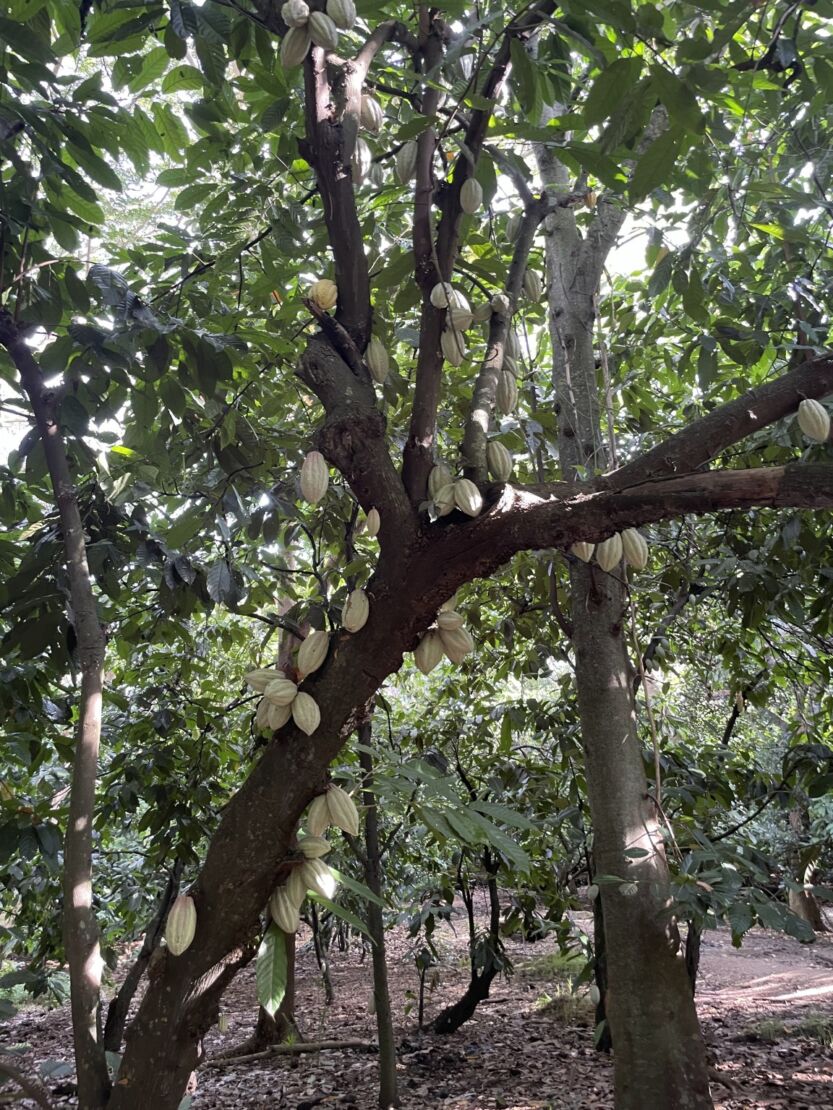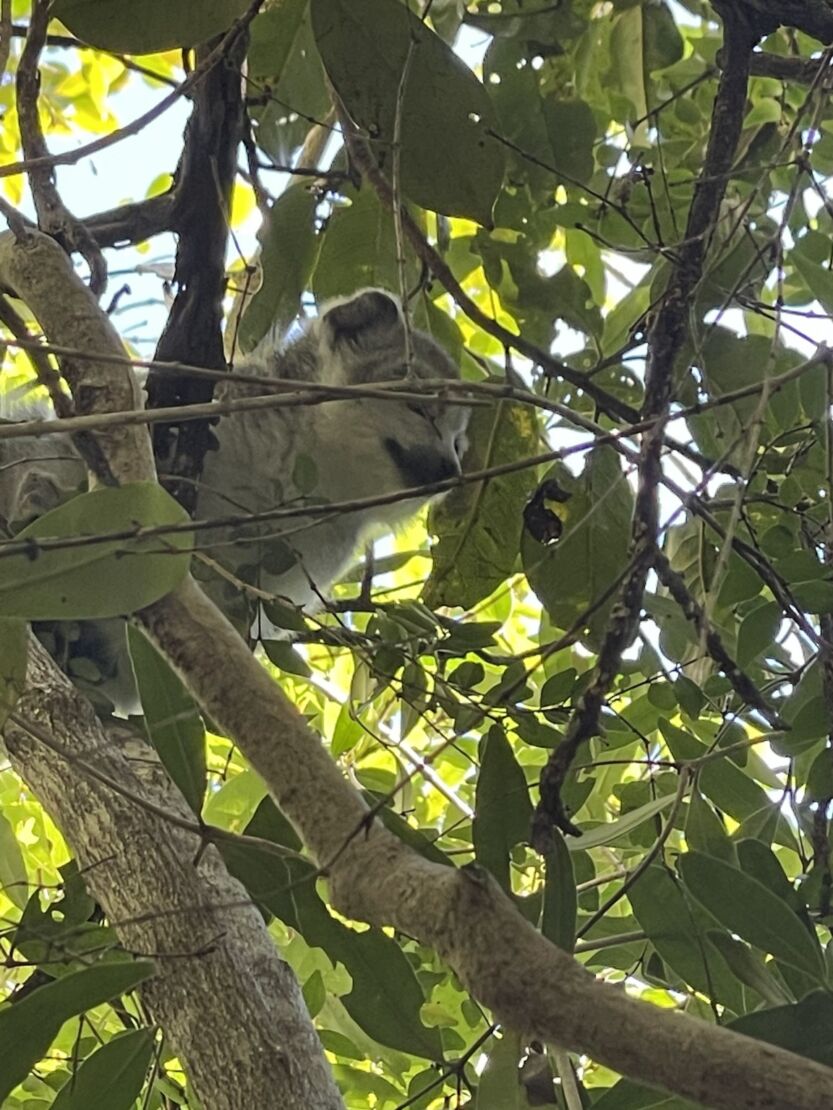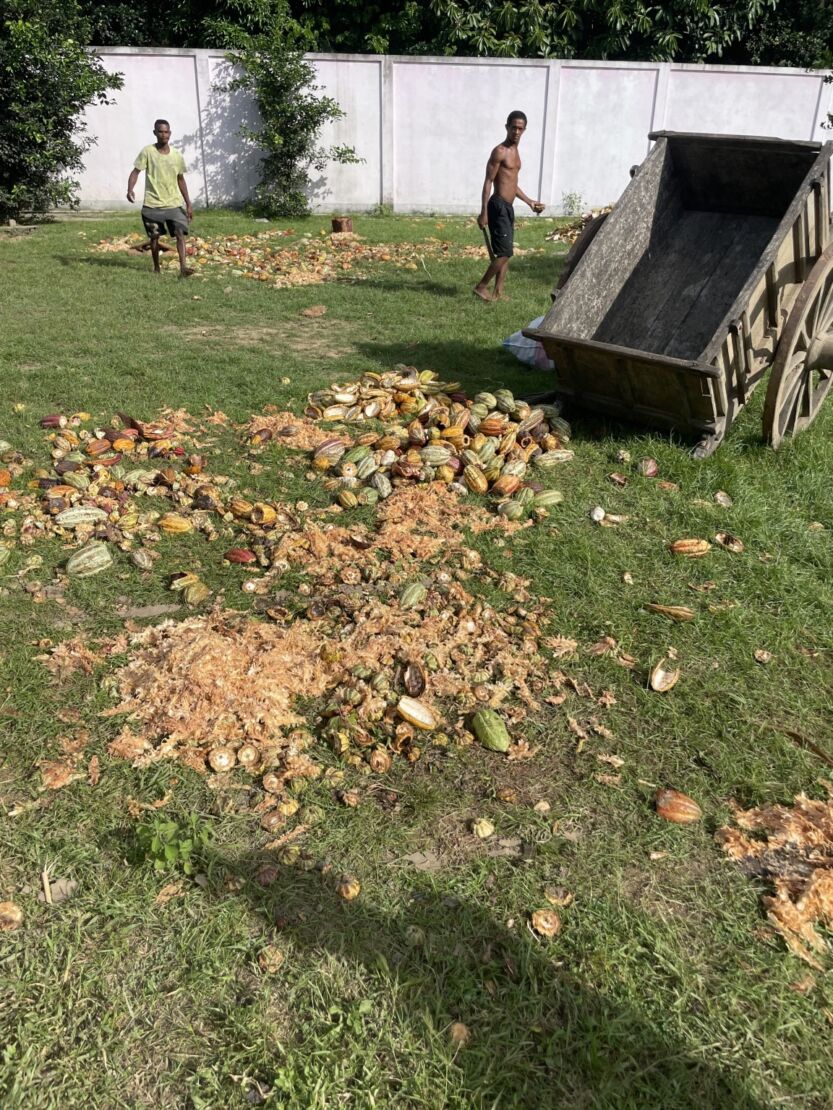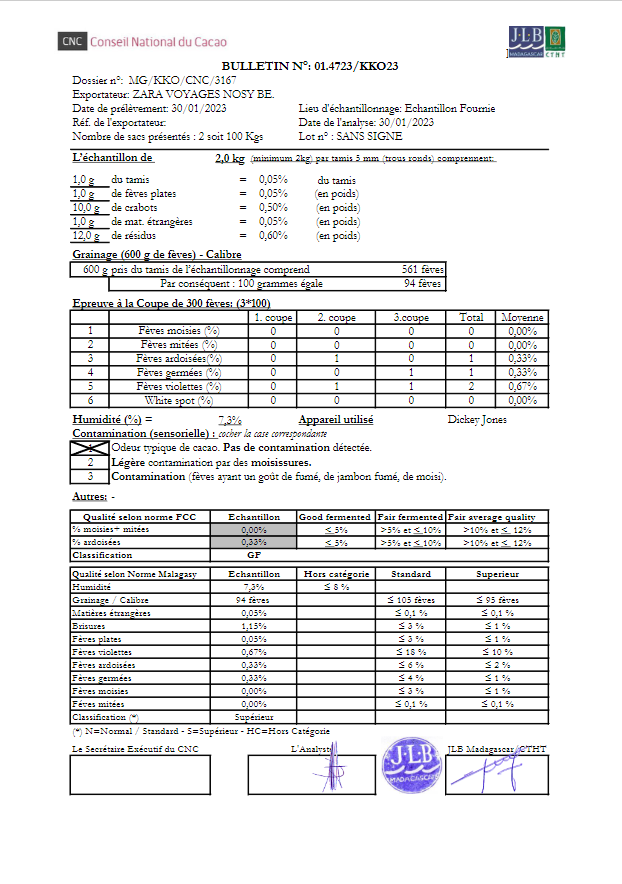




Cacao Processing – How Cacao is produced and prepared in Madagascar
1 – Cacao is grown in the Sambriano Valley of the northern Madagascar Maromokotra mountain Mountains and Sambirano River which feeds the Ambanja area cacao lands, seat of the best cacao. It is from here our farmers grow and supply to local BeantoBars, Cinagra, Robert, Beyond Good, and boutique chocolatieres in France, USA, Japan, and UK.
Cacao Farms at our planting plot:




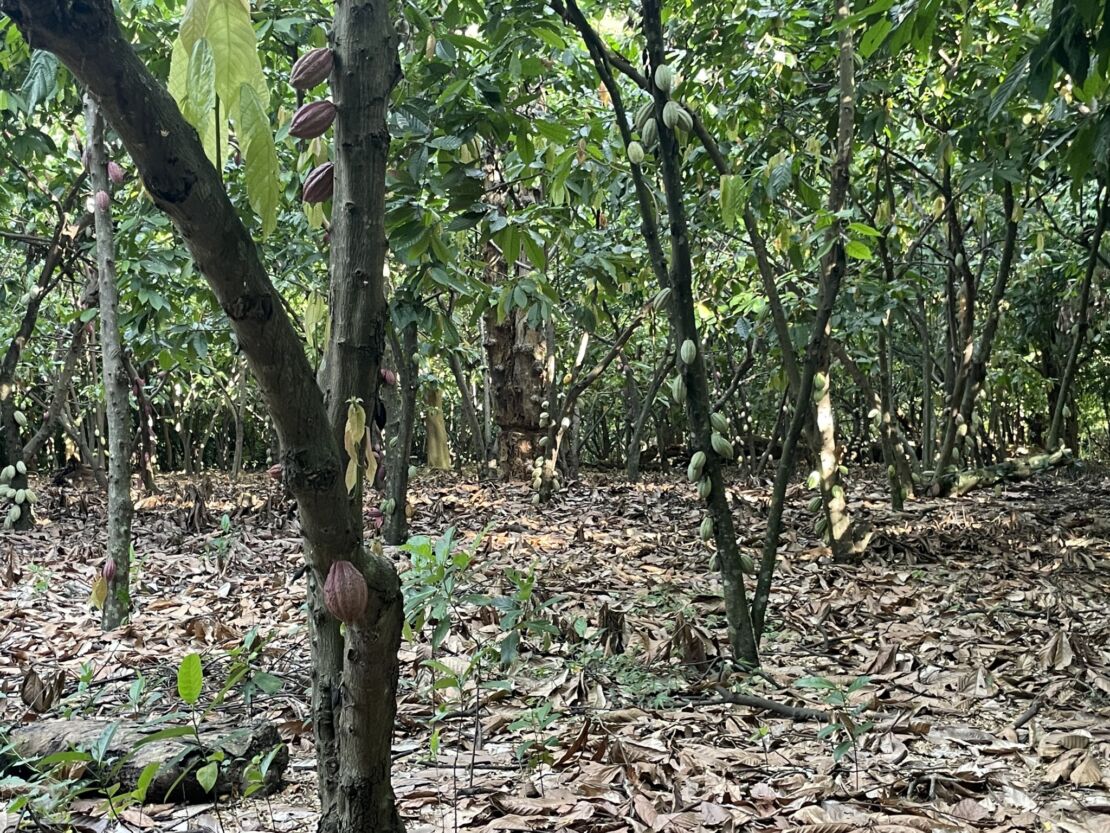
2 – As Vanilla is a vine pollinated via its flowers by a bee in its natural state, the cacao tree flowers in a star shaped “satellite dish” petal bloom, and the organism as a whole is pollinated by ants. In vanilla in Madagascar, humans can use the bourbon method to painstakingly hand pollinate the vanilla, and replace and mimic the natural role of the bee. In cacao, no such method is used in Madagascar, and the ant symbiant/dependent organism does this next part of the job.
Cacao (Criollo, or red kabos/pods in the picture) pollinated by the symbiant ant


3 – Farmers cut and collect for harvest the Cacao pods 4 times a year for conventional (Forastero) and 2 times a year for superior (Criollo)
Collecting the “Kabos” (the cacao pods) and bringing them to the central facility


4 – The kabos are thoroughly shelled and cut open length-wish like fruit, and the individual cacao beans in their juice and membrane are exposed and freed from the pod.
Cacao pods being split to expose the actual cacao beans and juicy pulp inside


*5 – For Ruby Chocolate (red/rose colored chocolate orders,) the special process is followed wherein citric acid is added to the pulp and unroasted, unfermented cacao beans. This protects the integrity of the natural pink-purple coloration which all cacao undergoes and phases through during the fermentation process. (The nibs inside stay pink/purple, rather then continuing throug the color spectrum to chocolate-brown color.)
*Citric Acid applied to fresh freed cacao beans to induce and protect the pink-purple color during the fermentation process, for ruby chocolate orders



6 – Cacao beans are fermented in custom wood fermentation rigs. Specific woods from specific Malagasy or imported/foreign trees are chosen for flavor just as wines or whiskeys are curated in their cask-selection. Some woods induce superior flavors in the fermented beans than others. This process takes less than a week before it is time to take the beans out to dry.
Madagascar Cacao beans ferment in the custom wood fermentation rigs and racks, with different woods and rigs selected and reserved for specific clients


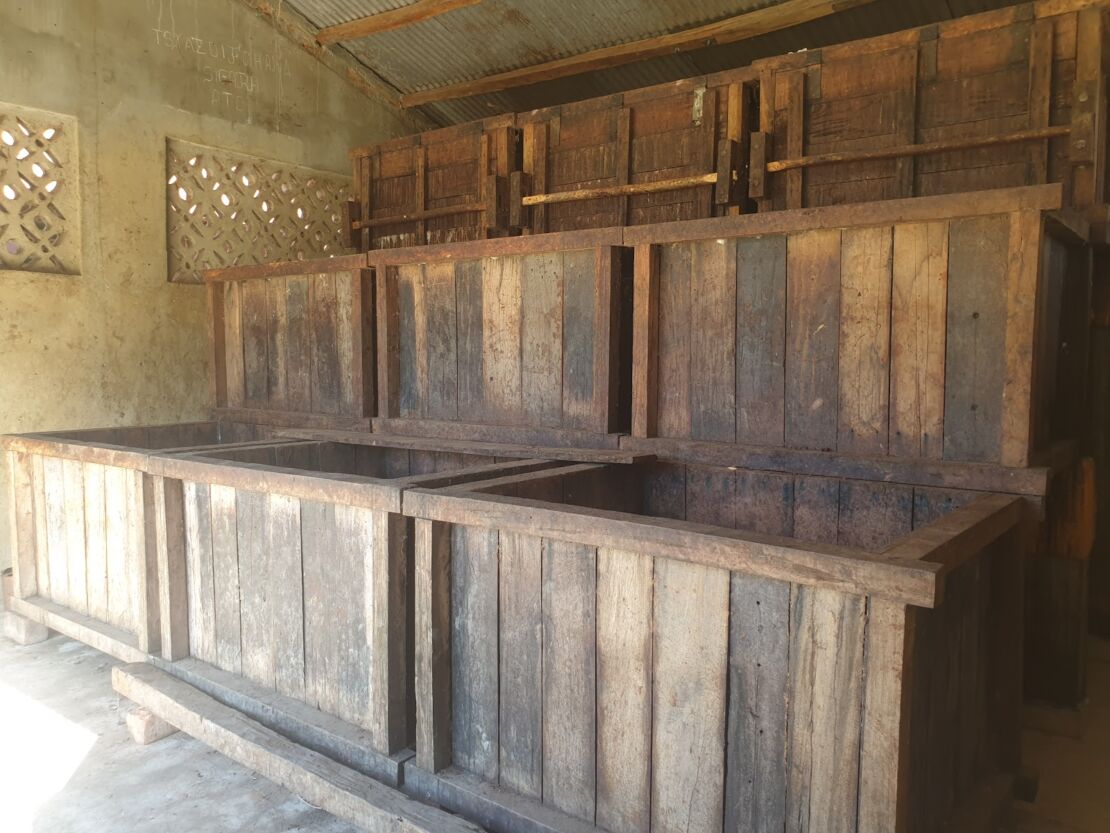
7 – Cacao beans are naturally dried out in the sun, with occasional shade cycles, outdoors with walled garden and drying yards to prevent pollution, particulate and contaminants outside, still in their shells so the cacao inside is clean and protected before roasting.
Cacao beans drying in the Sambirano Valley yards in Madagascar, in the sunshine

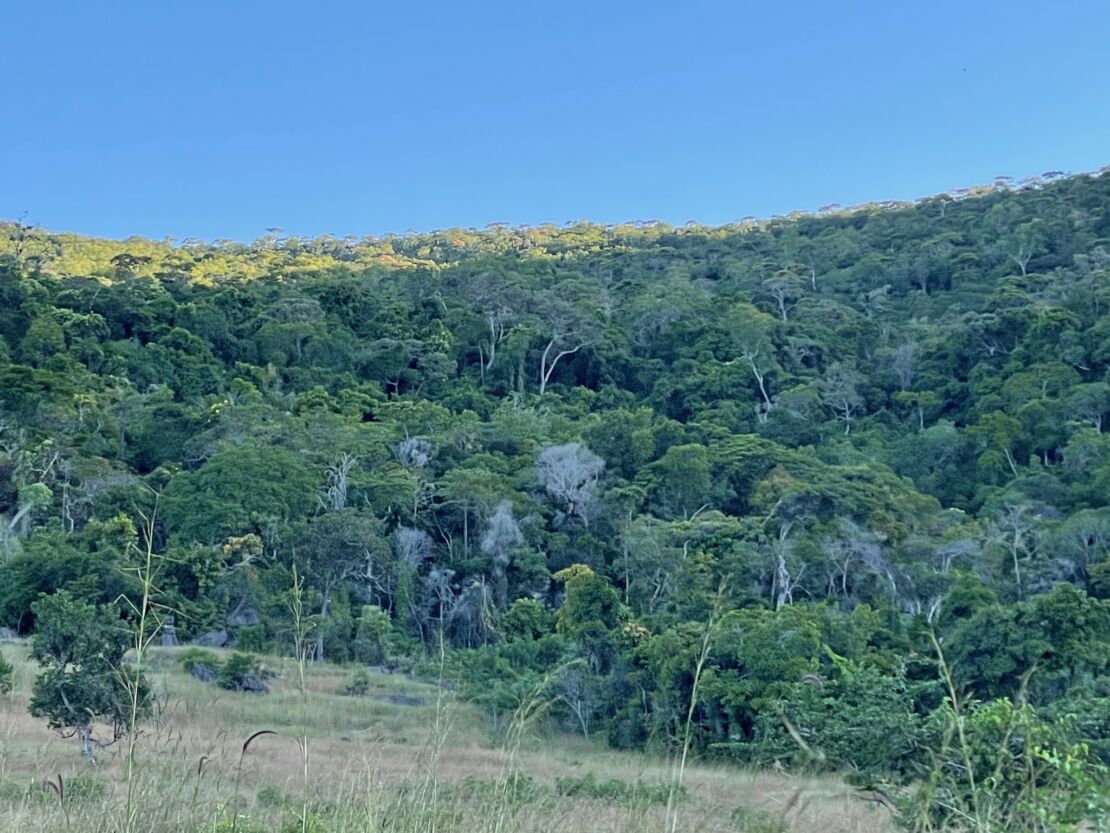

8 – Cacao beans are triaged and quality controlled, removing abnormal color/shape/smell/phenotype unroasted unshelled beans physically by hand. Beans of the best quality are put into jute fibrous sacs lined with plastic, as per cacao industry standard, and then again in boxes, for best packing results and regime.
Unroasted unshelled beans are put into packing configurations standard for the world cacao (cocoa) industry, directly at our facility near Ambanja, Madagascar, before loading
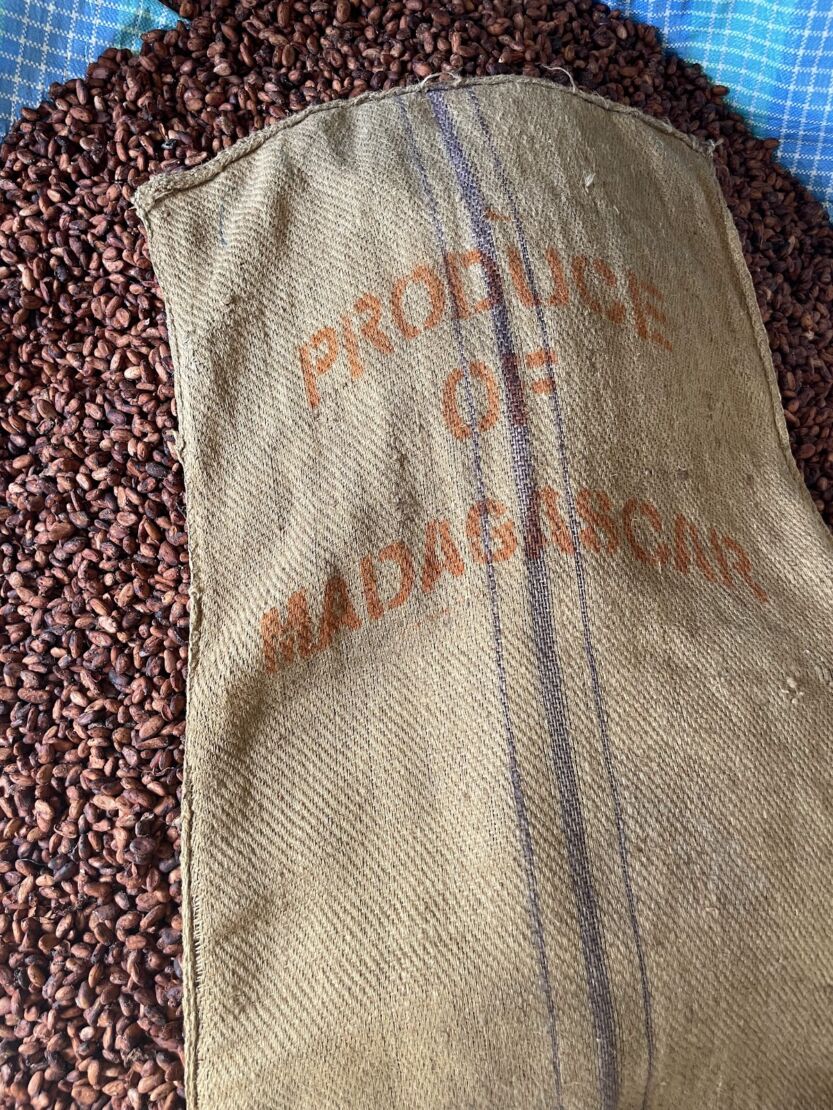


*9 – For orders specificing so, cacao beans before roast or sale are shelled by hand, into the premium intact whole shelled cacao nibs. This is a process only available here, as machines crush the nibs into smaller pieces otherwise. This makes a superior nib and taste for the high end market.
*Cacao beans are shelled by hand to be removed whole into edible entire beans (nibs)
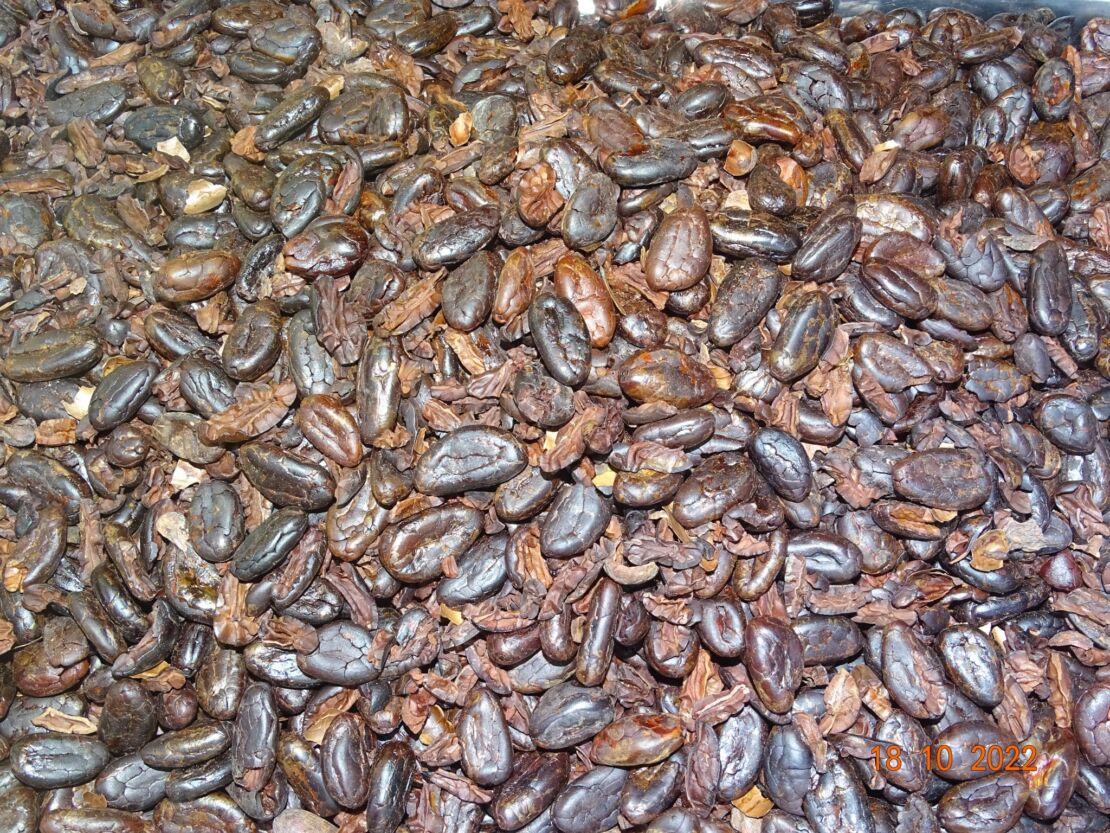
10 – Cacao sacks or boxed sacks are loaded by crew onto trucks bound for roasting or for Nosy Be Hellville port, or Fascene airport for outbound freight and export from Madagascar to the end client. Phytosanitary documents are obtained and mandatory for outgoing shipments, from authorities.
Madagascar cacao heads out of the facility for its future life as chocolate!


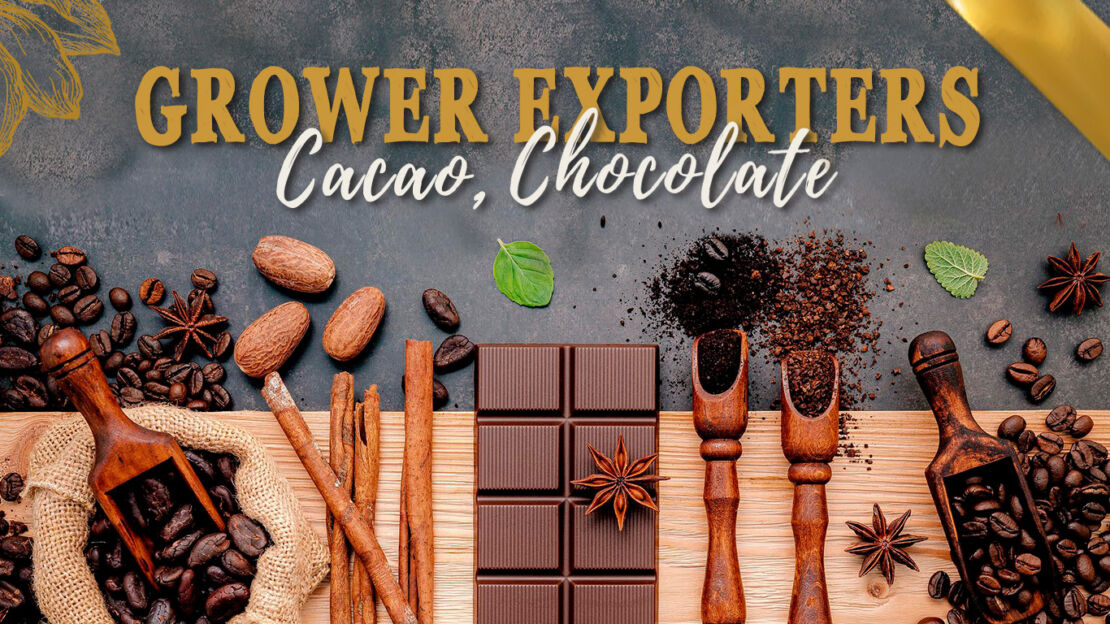
…and is made into chocolate products for the desserts and fine-diners of the world!
Madagascar CC Cacao Tastes and Tests Superior



Summary of Cacao Processing in Madagascar

Visit our facility in northern Madagascar
Or visit us at an expo in Europe, US, or Japan
Madagascar’s cacao is unique in its kind due to its refined fruity taste with mild acidic hints creating a true flavour bomb with unparalleled aroma. Our cacao’s exceptional aroma is the result of careful harvesting methods and a fermentation which is perfectionalized to the max, using top quality control.
We are proud to say that our cacao is cultivated without any fertilizers and our product is completely organic and free of chemicals and additives. Our beans are hand-harvested and carefully selected, only using the highest quality beans. They are therefore spread and dried in the sun between five and nine days, respecting the traditional process of drying and fermenting after shelling.
The pods are opened using a wooden stick to recover the bean, a processing which is called hulling. This can only be done with a wooden stick as other tools such as knives can damage the seeds.
Temperature and duration of fermenting are important factors for the fermentation process and you’ll need at least three to eight days, depending on the variety of the cacao. Mucilage eliminates and avoids germination and provokes the necessary reactions for optimal flavor development. The cacao beans are stirred every 24 to 48 hours during the fermentation process in order to facilitate aeration.
Brewing leads to a higher quality of the product as it improves and develops the work of the bacteria, followed by drying, respecting the ancient tradition of having the beans dried in the sun. The final step is storing the beans in which a rate of six to eight percent moisture has to be respected during storage. As there are no additives or chemicals used in this process, the product is 100 percent organic.
Cacao from Madagascar is truly unique and we don’t just say this improves sales as once you taste it you’ll see that due to its fine texture and its acidic fruity taste the aroma really is different from cacao from elsewhere in the world. This is why our cacao obtained the label ‘fine cacao’ issued by the International Cacao Organization (ICCO) in 2015. This ‘trophy’ is approved by the best chocolate makers in the world. Malagasy chocolate is known for its organic purity, making it one of the most sought-after kinds of cacao in the world as more and more customers are searching for a pure honest product.
More and more of the cacao in Madagascar is used to produce chocolate, resulting in a product of incredibly good purity thanks to the quality of the beans, professional focus of the farmers, the traditional methods and treatments of the beans, fermented and dried to perfection.
Ruby Madagascar Cacao and Chocolate.
Ruby Chocolate is simply made by addiing citric acid to the cacao during the fermentation process (when it is already turning purple.
With 3 months advance order we can produce also ruby cacao for you in mixed or criollo-only chocolate.

Historically, Madagascar was colonized by the French. Therefore, at the time of colonization, the French introduced cocoa in Madagascar at the beginning of the 20th century. They realized that the climate of the big island is well suited to the plantation of this exceptional plant, that’s why the local cocoa is the most demanded at the world level. It is famous for its quality, its taste and its unique aroma, hence the name “exceptional cocoa”. In 1904, a settler called Maillot made the very first cocoa plantation in the Malagasy territory in the North of Madagascar in Ambanja. But 95% of Madagascar’s cocoa production comes from the northeast of the island, more precisely in the Sambirano valley, near Ambanja. The local area produces three different varieties of cocoa namely the “criollo” a fragile variety, the “forastero” a resistant variety and another hybrid variety issued from the two previously mentioned varieties known as “trinitario”. Nowadays Madagascar produces more than 6,000 tons of cocoa plants without fertilizer.

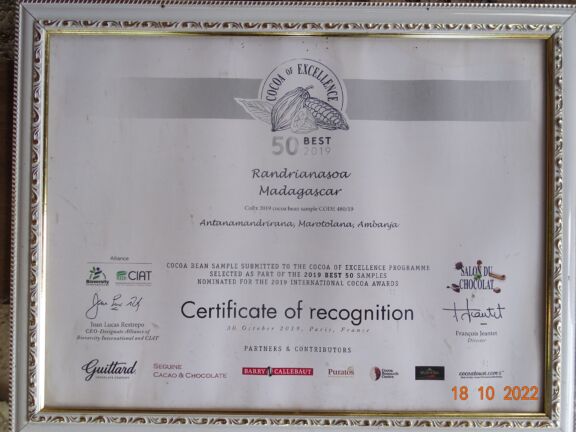






Order Criollo-Only (100% Criollo) Superior Cacao, Cacao Products, Couverture, and Chocolate

For distinct taste of chocolate that derives from and delivers the Madagascar unique flavor, professionals use Cacao Beans or Cacao Nibs. Not Mass. Commodity mass market mediocre chocolate producers use chocolate mass for realizing their final bars, but real excellent bean to bar starts with beans or nibs. Most giant chocolate companies use mass as their fuel and input as it makes it much easier to manufacture chocolate for them.
In general, we offer several formats and types of cocoa, we have a mixture of criollo, monastero, and trinitario. Let’s discover together how we manage to have such a unique product with just one fruit pod. The process starts around September. The harvesting of the cocoa is laborious work, the collaborating farmers collect the cocoa fruits from their trees and already begin to remove the fresh pulp by tapping it with a piece of wood so as not to contaminate the pulp because our cocoa bean comes from it.
During fermentation the beans turn from purple to brown (chocolate) color. Choosing the wood is important very much to the fermentation final affect as it reflects in the flavor. 2 types of local wood are best for this, but for novel flavors we’ve had clients ask us about flavoring cacao beans with palissandre (hazivola) and others as well. MCC can provide criollo-only cacao products well, as it is higher quality and rarer. Many of our clients for this are in Japan and highest-end markets. Our facility and fermentation place is certified organic and provided/provides the cacao for some of the best brands in America as well like Beyond good and Madecasse.
26 T of cocoa in 50 kg bags per 40 foot container
13 T of cocoa in 50 kg bags per 20 foot container
15 bags per palette,
750kg per pallete
Madagascar Cacao international shipping, packaging, and displays







